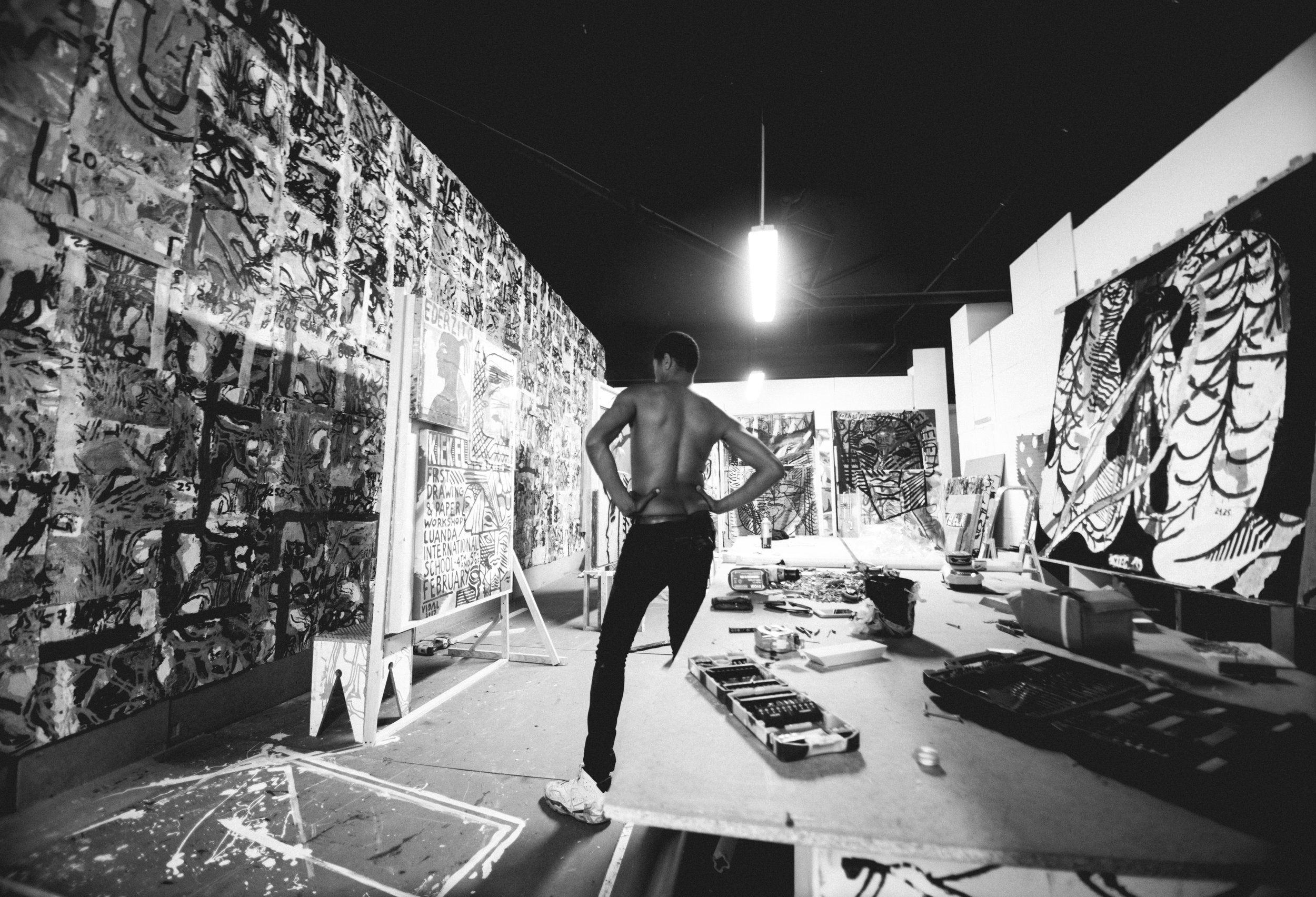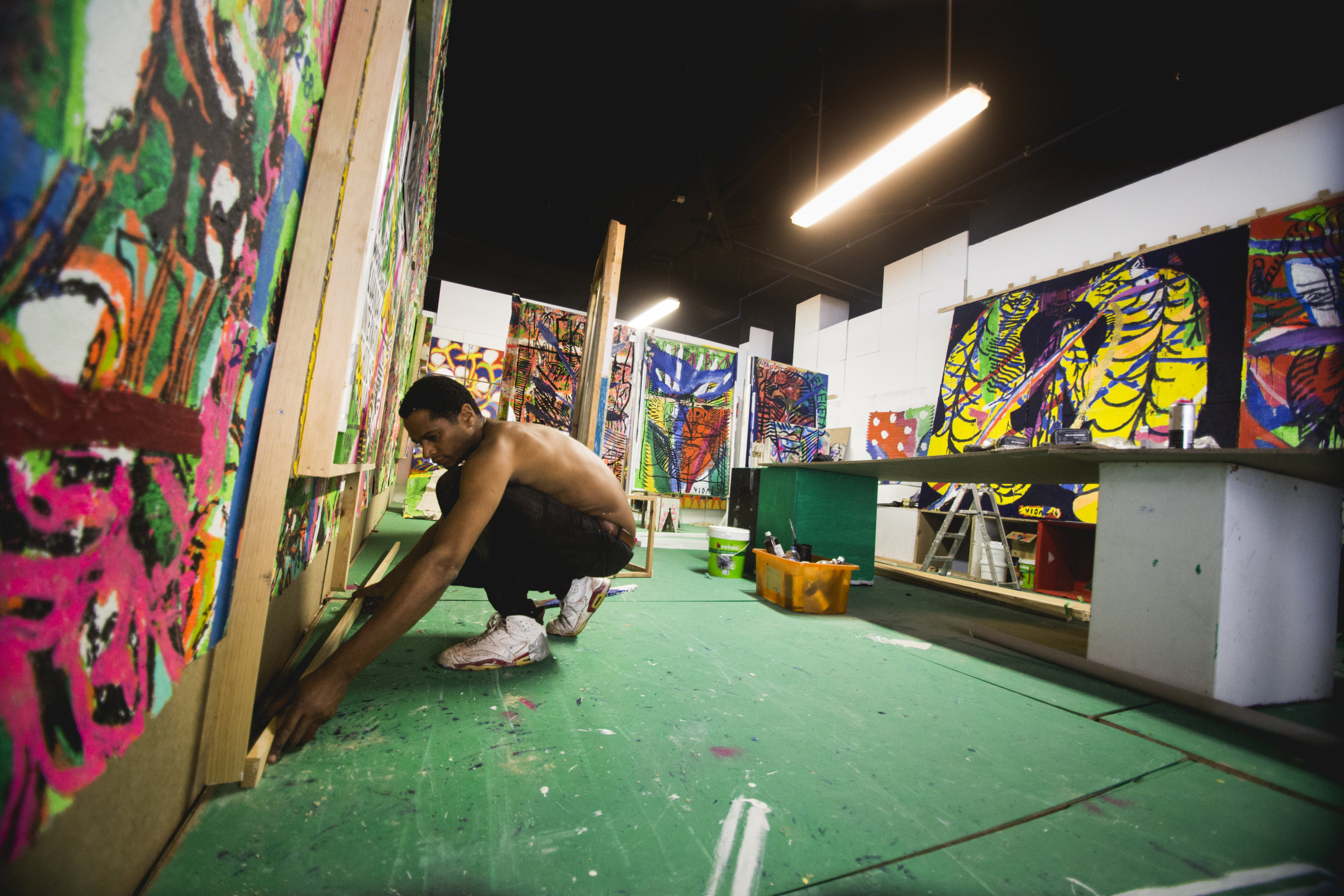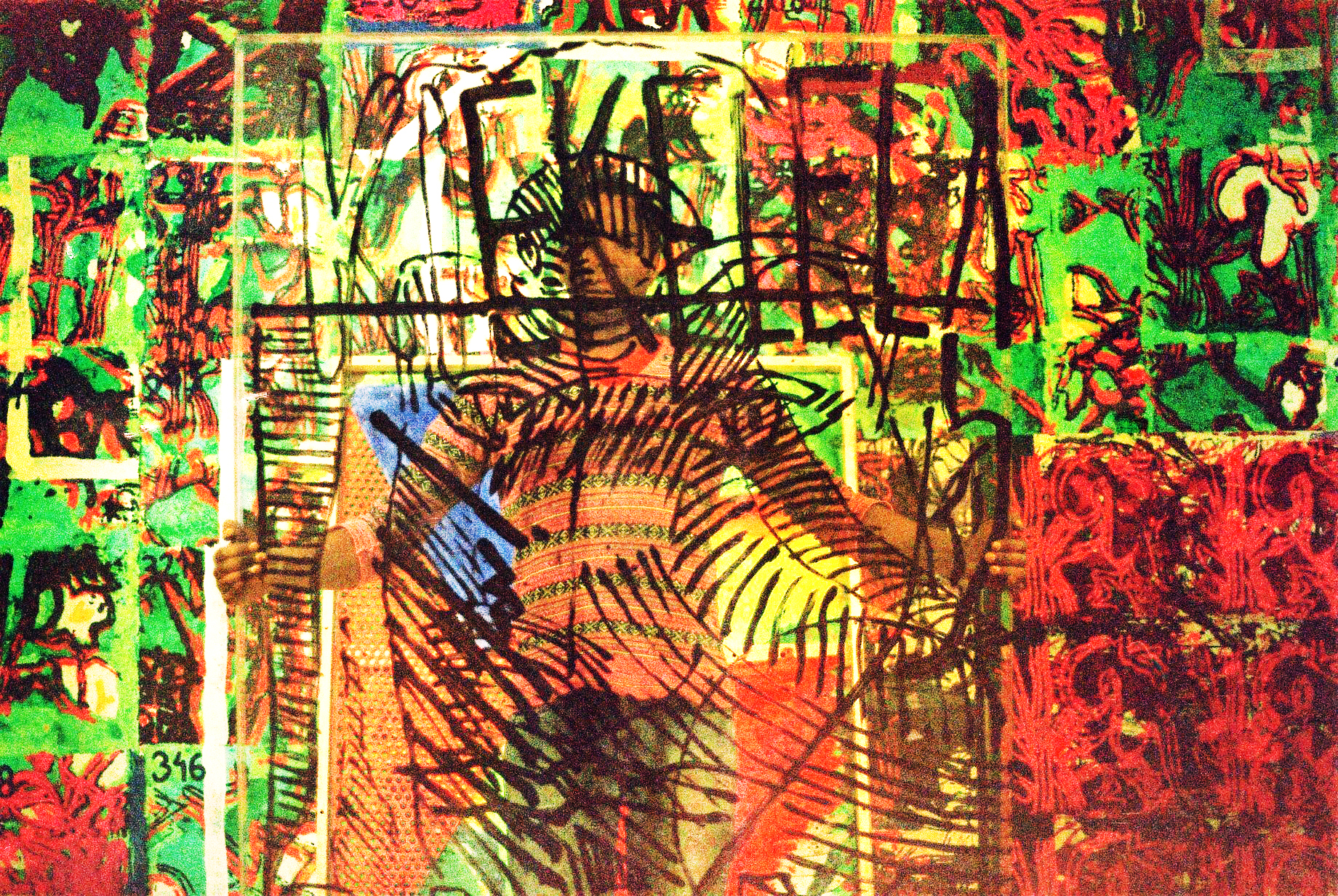
AGO 16 - NOV 17 | Francisco Vidal
Francisco Vidal Português, Angolano e Cabo Verdiano Nascido em 1978 em Lisboa, Portugal Reside e trabalha em Lisboa >>> A prática de Francisco Vidal enaltece ideias acerca trabalho e mobilidade internacional. Ele é conhecido pelas grandes instalações de pintura, traçando poderosas linhas caligráficas sobre telas de serigrafia, retratando flores de algodão em cores vivas e variados esquemas cromáticos. As flores fazem alusão a uma revolta liderada por trabalhadores agrícolas de uma lantação de algodão portuguesa/belga em Angola, em 1961. Este evento é considerado a primeira batalha da Guerra de Independência Angolana, e forma o centro da reflexão de Vidal sobre dissidência política, o espírito da revolução social e o legado do Marxismo no contexto do crescimento do mercado e da economia africana nos séculos 20 e 21. >>> Vidal concluiu um mestrado em Belas Artes pela Columbia University School of the Arts em Nova York. Uma das mais distintas vozes artísticas a emergir recentemente de Angola, ele foi parte da seleção oficial do Pavilhão Angolano na 56ª Bienal de Veneza (2015), e também representou Angola na Expo Milan (2015). Recentes exibições incluem: Museu Afro Brasil, São Paulo (2016), Tiwani Contemporary, Londres (2015), Freies Museum/Savvy Contemporary, Berlim (2015), Instituto Camões, Luanda (2014), UNAP, Luanda (2014), Fundação Caloute Gulbenkian, Lisboa (2010) e Institute Camões em Cabo Verde, Angola e Moçambique (2007). Seu trabalho também é representado em coleções públicas, incluindo a Fundação EDP, PLMJ Foundation e Fundação Calouste Gulbenkian, bem como coleções particulares.
Francisco Vidal, Portuguese, Angolan and Cape Verdean. Born in 1978 in Lisbon, Portugal. Lives and works in Lisbon
Francisco Vidal’s practice highlights ideas around labour and international mobility. He is known for his large painting installations layering bold, calligraphic line paintings on screen prints depicting vividly coloured cotton flowers in various chromatic schemes. The flowers refer to an uprising led by the agricultural workers of a Portuguese-Belgian cotton plantation in Angola in 1961. This event is considered the first battle of the Angolan War of Independence, and forms the core of Vidal’s reflection around political dissent, the spirit of social revolution and the legacy of Marxism within the context of trade and economic growth across Africa in the 20th and 21st centuries.
Vidal holds an MFA from Columbia University School of the Arts in New York. One of the most unique artistic voices recently to have emerged from Angola, he was part of the official selection of the Angolan Pavilion at the 56th Venice Biennale (2015), and also represented Angola at Expo Milan (2015). Recent exhibitions include: Museu Afro Brasil, São Paulo (2016), Tiwani Contemporary, London (2015), Freies Museum/Savvy Contemporary, Berlin (2015), Instituto Camões, Luanda (2014), UNAP, Luanda (2014), Caloute Gulbenkian Foundation, Lisbon (2010) and Institute Camões in Cape Verde, Angola and Mozambique (2007). His work is represented in public collections including the EDP Foundation, PLMJ Foundation and Calouste Gulbenkian Foundation, as well as private collections.

OUT 17: Vidal em produção para segunda parte de sua exposição "Luuanda Rising"
OCT 17 - Vidal in progress for the second part of his exhibition "Luuanda Rising"
photo: Maju Reis

OUT 17: Vidal em produção para segunda parte de sua exposição "Luuanda Rising"
OCT 17 - Vidal in progress for the second part of his exhibition "Luuanda Rising"
photo: Maju Reis

OCT 17: Moments of inspiration "Luuanda Rising"
photo: Maju Reis

OUT 17: Vidal em produção para segunda parte de sua exposição "Luuanda Rising"
OCT 17 - Vidal in progress for the second part of his exhibition "Luuanda Rising"
photo: Marcela Vaz

OUT 17: Vidal em produção para segunda parte de sua exposição "Luuanda Rising"
OCT 17 - Vidal in progress for the second part of his exhibition "Luuanda Rising"
photo: Maju Reis

OUT 17: Vidal em produção para segunda parte de sua exposição "Luuanda Rising"
OCT 17 - Vidal in progress for the second part of his exhibition "Luuanda Rising"
photo: Maju Reis

photo: Maju Reis

OUT 17: Vidal em produção para segunda parte de sua exposição "Luuanda Rising"
OCT 17 - Vidal in progress for the second part of his exhibition "Luuanda Rising"
photo: Maju Reis

MAIO 2017: Escola de Papel
"a ferramenta que está nos detalhes de todos os dias; o papel da base do que somos; o desenho com toda poesia; o sopro que se atira contra parede e recebe de volta o seu próprio vento; a Kiekelela do kimbundo; a escola de papel".
MAY 2017: Paper School
"it's the tool that is in the details of everyday, paper gives the base of who we are, it's drawing and poetry, the breath that is thrown against a wall, and its received back by the same gush of wind, the Kiekelela do kimbundo, the paper school."

MAIO 2017 - "Escola de Papel" - segundo projeto de Vidal durante sua residência
MAY 2017 - "Paper School" - Vidal's second project during the residency

MAIO 2017 - "Escola de Papel" - segundo projeto de Vidal durante sua residência
MAY 2017 - "Paper School" - Vidal's second project during the residency
photo: Hugo Inglez


ABR 2017: Kame Sousa and Francisco Vidal para exposição "Territórios".
APR 2017: Kwame Sousa and Francisco Vidal for the exhibition "Territórios".
photo: Lucca Miranda

ABR 2017: Vernissage Exposição "Territórios"
APR 2017: Vernissage Exhibition "Territórios"

ABR 2017: Vidal em montagem para exposição "Territórios: Utopia Luanda Machine".
APR 2017: Vidal in progress for the exhibition "Territórios: Utopia Luanda Machine".
photo: Lucca Miranda

ABR 2017: Vidal em montagem para exposição "Territórios: Utopia Luanda Machine".
APR 2017: Vidal in progress for the exhibition "Territórios: Utopia Luanda Machine".
photo: Lucca Miranda

ABR 2017: Vidal em montagem para exposição "Territórios: Utopia Luanda Machine".
APR 2017: Vidal in progress for the exhibition "Territórios: Utopia Luanda Machine".
photo: Lucca Miranda

ABR 2017: Vidal em montagem para exposição "Territórios: Utopia Luanda Machine".
APR 2017: Vidal in progress for the exhibition "Territórios: Utopia Luanda Machine".
photo: Lucca Miranda

ABR 2017: Kiekelela por Francisco Vidal para exposição "Territórios: Utopia Luanda Machine".
APR 2017: Kiekelela by Francisco Vidal for the exhibition "Territórios: Utopia Luanda Machine".
photo: Lucca Miranda

SET 2016 - trabalho para participação de sua primeira exposição fora da galeria, Portugual Portugueses - Museu Afro Brasil- SP | curadoria de Emanoel Araújo
SEP 2016 - work for his first exhibition outside the gallery, the collective Portugal Portugueses at Museu Afro Brasil - SP | Emanoel Araújo curatorship

SET 2016 - trabalho em progresso para participação de sua primeira exposição fora da galeria, Portugual Portugueses - Museu Afro Brasil- SP | curadoria de Emanoel Araújo
SEP 2016 - work in progress for his first exhibition outside the gallery, the collective Portugal Portugueses at Museu Afro Brasil - SP | Emanoel Araújo curatorship

OUT 2016 - Francisco Vidal em um momento descontraído no atelier com seu compatriota e artista, Januário Jano
OCT 2016 - Francisco Vidal having a good time with his friend, the also Angolan artist Januário Jano


SET 2016 - Summer School - primeiro projeto de Vidal durante sua residência artística
SEP 2016 - first project inside Wozen’s residency, The Summer School

AGO 2016 - Primeira atividade junto a comunidade local dentro da residência artística - DIY | Serigrafia Experimental
AGO 2016 - Vidal's first activity inside Wozen’s residency, DIY - silkcreen

AGO 2016 - Vidal e o artista moçambicano Malenga, primeira atividade dentro da residência artística - DIY | Serigrafia Experimental
AGO 2016 - Vidal and the Mozambican artist Malenga during the first activity inside Wozen’s residency - DIY - silkcreen

AGO 2016 - Primeira atividade junto a comunidade local dentro da residência artística - DIY | Serigrafia Experimental
AGO 2016 - Vidal's first activity inside Wozen’s residency, DIY - silkcreen

AGO 2016 - montagem para sua primeira participação dentro da galeria, exposição colectiva GLOCAL
AGO 2016 - setting up for his first project inside the gallery, the collective exhibition GLOCAL

AGO 2016 - montagem para sua primeira participação dentro da galeria, exposição colectiva GLOCAL
AGO 2016 - setting up for his first project inside the gallery, the collective exhibition GLOCAL

AGO 2016 - O primeiro mês de residência artística
AGO 2016 - The first month of the residency






























